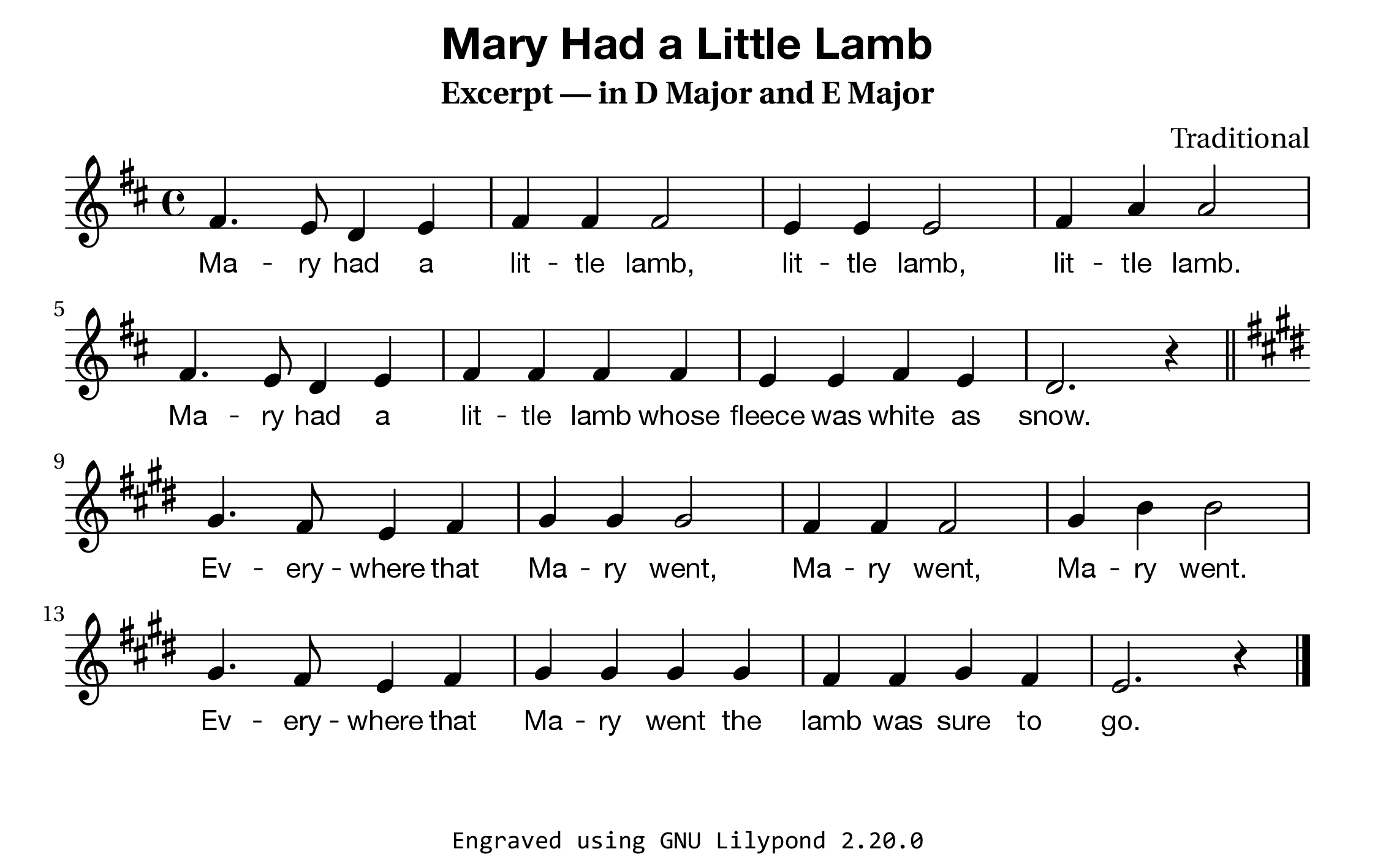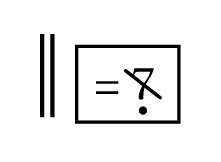Engraving a Simple Song: “Mary Had a Little Lamb - in D Major and E Major” in Solmisasi
Let’s first engrave this song in standard (Western) music notation, without an include to the solmisasi-lily library. The snippet would be something like this.
\version "2.20.0"
\paper {
% some paper settings goes here...
}
\header {
title = \markup { \sans "Mary Had a Little Lamb" }
subtitle = "Excerpt — in D Major and E Major"
composer = "Traditional"
tagline = \markup {
\typewriter \fontsize #-1 {
\concat {
"Engraved using GNU Lilypond "
#(string-join (map (lambda (v) (number->string v)) (ly:version)) ".")
}
}
}
}
mary_in_d_maj_notes = {
\key d \major
\relative d' {
fis4. e8 d4 e |
fis4 4 2 |
e4 4 2 |
fis4 a4 2 | \break
fis4. e8 d4 e |
fis4 4 4 4 |
e e fis e |
d2. r4
}
}
mary_music = {
\time 4/4
\mary_in_d_maj_notes
\bar "||"
\transpose d e \mary_in_d_maj_notes
\bar "|."
}
mary_lyric = \lyricmode {
% Verse 1
Ma -- ry had a lit -- tle lamb,
lit -- tle lamb, lit -- tle lamb.
Ma -- ry had a lit -- tle lamb whose
fleece was white as snow.
% Verse 2
Ev -- ery -- where that Ma -- ry went,
Ma -- ry went, Ma -- ry went.
Ev -- ery -- where that Ma -- ry went
the lamb was sure to go.
}
\score {
<<
\new Staff {
\new Voice { \mary_music }
\addlyrics { \mary_lyric }
}
>>
\layout {
\context {
\Lyrics
\override LyricText.font-family = #'sans
\override LyricText.font-size = #0
\override LyricHyphen.Y-offset = #0.2
\override LyricHyphen.minimum-distance = #2.0
}
}
}
And here is the compilation result.

Now, let’s transform that score into solmisasi notation. Here is the snippet and its compiled result.
\version "2.20.0"
\include "solmisasi.ily"
\paper {
% some paper settings goes here...
}
\header {
title = \markup { \sans "Mary Had a Little Lamb" }
subtitle = "Excerpt — in D Major and E Major"
composer = "Traditional"
tagline = \markup {
\typewriter \fontsize #-1 {
\concat {
"Engraved using GNU Lilypond "
#(string-join (map (lambda (v) (number->string v)) (ly:version)) ".")
" — with solmisasi-lily v1.0.0"
}
}
}
}
mary_in_d_maj_notes = {
\key d \major
\relative d' {
fis4. e8 d4 e |
fis4 4 2 |
e4 4 2 |
fis4 a4 2 | \break
fis4. e8 d4 e |
fis4 4 4 4 |
e e fis e |
d2. r4
}
}
mary_music = {
\time 4/4
\mary_in_d_maj_notes
\bar "||"
\transpose d e \mary_in_d_maj_notes
\bar "|."
}
mary_lyric = \lyricmode {
% Verse 1
Ma -- ry had a lit -- tle lamb,
lit -- tle lamb, lit -- tle lamb.
Ma -- ry had a lit -- tle lamb whose
fleece was white as snow.
% Verse 2
Ev -- ery -- where that Ma -- ry went,
Ma -- ry went, Ma -- ry went.
Ev -- ery -- where that Ma -- ry went
the lamb was sure to go.
}
\score {
<<
\new SolmisasiTimeAndKeySignature {
\solmisasiMusic \mary_music
}
\new SolmisasiStaff {
\new SolmisasiVoice {
\solmisasiMusic \mary_music
}
\addlyrics {
\solmisasiLyric \mary_lyric
}
}
>>
\layout {
\context {
\Lyrics
\override VerticalAxisGroup.nonstaff-relatedstaff-spacing.basic-distance = #0
\override LyricText.font-family = #'sans
\override LyricText.font-size = #0
\override LyricHyphen.Y-offset = #0.2
\override LyricHyphen.minimum-distance = #2.0
}
}
}

In the compiled result, there is a new object printed at the end of the second system, as shown by the following image.

This object was engraved by a special custom engraver named Solmisasi_equivalence_key_engraver, with the purpose of telling the score users/readers about the equivalence of the last note, before the change of the key signature, in the new key signature. It is a common practice in writing music in solmisasi notation. However, this object could be omitted, if you want to.
If you carefully look at the latest snippet, you’ll find a new music function named \solmisasiLyric. What is this, and why do I need this function?
In this version, solmisasi-lily treats both input notes and rests as notes. In the case of a rest-event or multi-measure-rest found, it will be treated as a note-event. Therefore, Lilypond’s Lyric_engraver will also print the lyric syllables below/above a solmisasi rest (printed as 0). So, I decided to code a simple function, named \solmisasiLyric, to overcome this problem. If I have time in the future, I will implement a dedicated .Rest_engraver in the next version of solmisasi-lily library
However, there are other alternative ways, such as:
- inserting a
\skipor an empty string ("") in lyric mode to be associated with a solmisasi rest. This way, the lyrics sequence will differ to the one in standard notation system. - occupying a
NullVoicecontext, which holds the original non-converted music, to be used as the associated voice for the lyrics. This way, we’d better create an explicitLyricscontext to handle the lyrics.